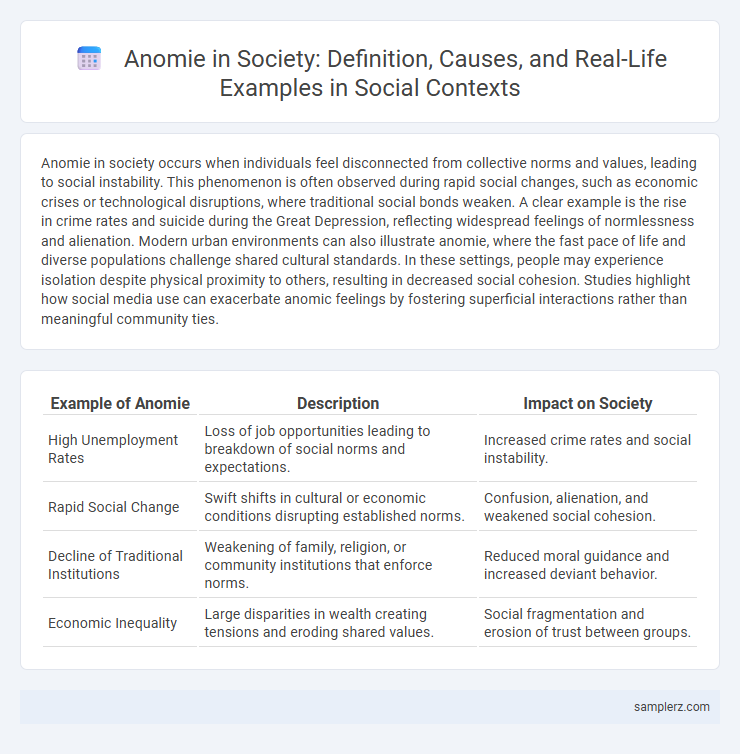Anomie in society occurs when individuals feel disconnected from collective norms and values, leading to social instability. This phenomenon is often observed during rapid social changes, such as economic crises or technological disruptions, where traditional social bonds weaken. A clear example is the rise in crime rates and suicide during the Great Depression, reflecting widespread feelings of normlessness and alienation. Modern urban environments can also illustrate anomie, where the fast pace of life and diverse populations challenge shared cultural standards. In these settings, people may experience isolation despite physical proximity to others, resulting in decreased social cohesion. Studies highlight how social media use can exacerbate anomic feelings by fostering superficial interactions rather than meaningful community ties.
Table of Comparison
| Example of Anomie | Description | Impact on Society |
|---|---|---|
| High Unemployment Rates | Loss of job opportunities leading to breakdown of social norms and expectations. | Increased crime rates and social instability. |
| Rapid Social Change | Swift shifts in cultural or economic conditions disrupting established norms. | Confusion, alienation, and weakened social cohesion. |
| Decline of Traditional Institutions | Weakening of family, religion, or community institutions that enforce norms. | Reduced moral guidance and increased deviant behavior. |
| Economic Inequality | Large disparities in wealth creating tensions and eroding shared values. | Social fragmentation and erosion of trust between groups. |
Understanding Anomie: A Breakdown of Social Norms
Anomie occurs when social norms weaken or break down, leading to a state of normlessness where individuals feel disconnected from collective expectations. This phenomenon often arises during rapid social change or economic instability, causing increased feelings of alienation and purposelessness among members of society. Understanding anomie is crucial for addressing social fragmentation and restoring cohesion through clear, shared values and regulatory mechanisms.
Digital Isolation: Social Media’s Role in Modern Anomie
Digital isolation exemplifies modern anomie by disrupting traditional social bonds through excessive social media use, leading to feelings of loneliness and detachment despite increased online connectivity. Studies show that prolonged exposure to curated online personas fosters social comparison, eroding genuine interpersonal relationships and community engagement. This phenomenon contributes to a fragmented social fabric, where individuals experience normlessness and a decline in collective belonging.
Urbanization and the Rise of Alienation
Rapid urbanization intensifies social alienation as individuals migrate to sprawling cities, losing traditional community bonds and shared values, which fosters feelings of isolation and normlessness. High population density coupled with anonymity in urban environments disrupts established social networks, contributing to a pervasive sense of disconnection and social instability. This widespread alienation exemplifies anomie by undermining societal cohesion and diminishing collective consciousness in modern urban settings.
Youth Disengagement: Anomie Among Younger Generations
Youth disengagement exemplifies anomie through the breakdown of social norms and values among younger generations, leading to feelings of isolation and purposelessness. Rising rates of unemployment, educational disparities, and digital alienation contribute to youth withdrawing from civic participation and community involvement. This social disintegration fosters increased risk of delinquency and mental health issues within the affected demographic.
Economic Instability and Its Impact on Social Cohesion
Economic instability disrupts social cohesion by increasing unemployment rates and financial insecurity, which lead to feelings of isolation and normlessness known as anomie. In societies facing prolonged economic downturns, crime rates and social unrest tend to rise as individuals struggle to find stable roles within the community. The breakdown of traditional social bonds and trust due to economic hardship weakens collective values and exacerbates social fragmentation.
Anomie in Educational Institutions: Lost Sense of Belonging
Anomie in educational institutions manifests as a lost sense of belonging among students, leading to increased feelings of isolation and disengagement. This social disintegration often results in higher dropout rates and diminished academic performance. Schools experiencing anomie struggle to foster community and shared values, undermining students' motivation and well-being.
Family Structure Changes and the Feeling of Rootlessness
Family structure changes, such as increased divorce rates and single-parent households, contribute significantly to anomie by disrupting traditional social bonds and norms. This transformation often leads to feelings of rootlessness and social isolation among individuals, weakening the sense of belonging. As family units become less stable, societies experience a decline in shared values and collective identity, intensifying anomie.
Political Polarization as a Symptom of Social Anomie
Political polarization exemplifies social anomie by eroding shared norms and values within society, leading to fragmented communities and weakened social cohesion. As conflicting ideologies intensify, trust in political institutions and fellow citizens declines, fostering alienation and instability. This breakdown in collective agreement undermines democratic processes and exacerbates social division, highlighting the critical impact of social anomie on political dynamics.
Crime Rates and Anomie: A Societal Correlation
Crime rates often rise in societies experiencing anomie, reflecting weakened social norms and diminished collective conscience. Studies show that communities with high levels of social disintegration and normlessness report increased incidences of violent crime and property offenses. This correlation highlights how the breakdown of social cohesion directly impacts criminal behavior and public safety.
Addressing Anomie: Building Stronger Community Bonds
Addressing anomie requires fostering social cohesion through community engagement initiatives, such as neighborhood associations and local events that encourage interpersonal connections. Strengthening social bonds reduces feelings of isolation by promoting shared values and collective responsibility among residents. Investing in supportive social networks and accessible public spaces cultivates a resilient community where individuals feel valued and connected.

example of anomie in society Infographic
 samplerz.com
samplerz.com